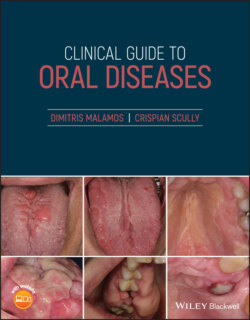Читать книгу Clinical Guide to Oral Diseases - Crispian Scully - Страница 35
Case 2.10
ОглавлениеFigure 2.10
CO: A 62‐year‐old man presented to the Oral Medicine Clinic with an enlarged bluish‐red lesion on his tongue.
HPC: The lesion had been present since the age of two, and showed a tendency to expand during adolescence, but had remained unchanged in size and color since then.
PMH: Asbestosis was his main serious problem. This is chronic respiratory failure due to chronic exposure to asbestos at work, and was treated with bronchodilator inhalers; oxygen supply and wide spectrum antibiotics in crisis. He had no history of other serious diseases, apart from two minor operations, one for removal of his appendix and the other for hemorrhoids.
OE: Oral examination revealed a rubbery, spongy bluish mass located at the dorsum of the tongue adjacent to the right lower molars (Figure 2.10). According to the patient, this lesion is asymptomatic, but unstable as it changes its color and size with pressure and consumption of hot foods or drinks respectively. No other similar lesions within his mouth or on the facial skin or cervical lymphadenopathy were recorded.
Q1 What is the possible diagnosis?
1 Cyanosis
2 Hemangioma
3 Melanoma
4 Lingual arteritis
5 Kaposi's sarcoma
Answers:
1 No
2 Hemangioma is a benign vascular lesion characterized by an abnormal proliferation of blood vessels that appears at birth or during the patient's early life with a tendency to subside over time. This lesion is formed by blood vessels and its color ranges from dark red to blue. Local pressure moves blood from the lesion and makes it brighter in color and smaller in size.
3 No
4 No
5 No
Comments: Kaposi's sarcoma and melanoma are malignant tumors but their clinical characteristics (i.e. presence of similar local or distant and satellite lesions associated with lympho‐adenopathy and a lethal course) do not fit with patient's lesion characteristics. Oral cyanosis is a common sign of chronic respiratory failure as was diagnosed in this patient, but cyanosis is not the cause as this is a diffuse and flat rather than localized swelling. Lingual arteritis is a very painful inflammation of the lingual artery, short in duration and causes severe tongue necrosis, and is therefore easily excluded from the diagnosis.
Q2 Which are the common histological characteristics of capillary and cavernous hemangiomas?
1 Increased proliferation of endothelial cells
2 Calcified thrombus formation (phlebolith)
3 Fibrous septa
4 Dense accumulation of inflammatory cells within the submucosa
5 Cholesterol crystals
Answers:
1 Endothelial cell hyperplasia with or without lumen formation is characteristic of hemangiomas, especially at their proliferative phase. The endothelial cells are dense and form clusters or small vascular channels prominent at the proliferative phase (capillary hemangiomas) or they form large cystic dilated vessels with thin walls (cavernous type).
2 No
3 Fibrous septa separate the neoplastic vascular lumens and are more numerous and dense at the involuting phase of the hemangiomas.
4 No
5 No
Comments: Cholesterol crystals are associated with chronic vascular inflammation, as well as being commonly seen in atheromatous plaques and in the inflamed cystic wall of dental cysts, but not in hemangiomas. Inflammation of the fibrous hemangioma's stroma is rare and mainly consists of chronic inflammatory cells, mast cells and a few macrophages. Phleboliths are formed from clots within the lumen of cavernous hemangiomas only.
Q3 Which of the syndromes below is/or are associated with cavernous hemangiomas?
1 Sturge‐Weber syndrome
2 Maffucci syndrome
3 Blue rubber bleb nevus
4 PHACE syndrome
5 Klinefelter syndrome
Answers:
1 No
2 Maffucci syndrome is associated with multiple enchondromas, mainly on the bones of hands and feet as well as hemangiomas.
3 Blue rubber bleb nevus syndrome is characterized by multiple hemangiomas (cavernous in majority) in the skin and visceral organs.
4 PHACE syndrome is a cutaneous syndrome characterized by multiple congenital abnormalities of posterior fossa, hemangiomas, and other vascular abnormalities, cardiac, and eye defects, sternal clefts and supraumbilical raphe syndrome.
5 No
Comments: Klinefelter syndrome is characterized by a number of oral abnormalities apart from hemangiomas and occurs exclusively in males, while Sturge‐Weber syndrome is characterized by capillary lesions of leptomininges and facial skin (nevus flammeus) along the distribution of ophthalmic and maxillary divisions of the trigeminal nerve.
